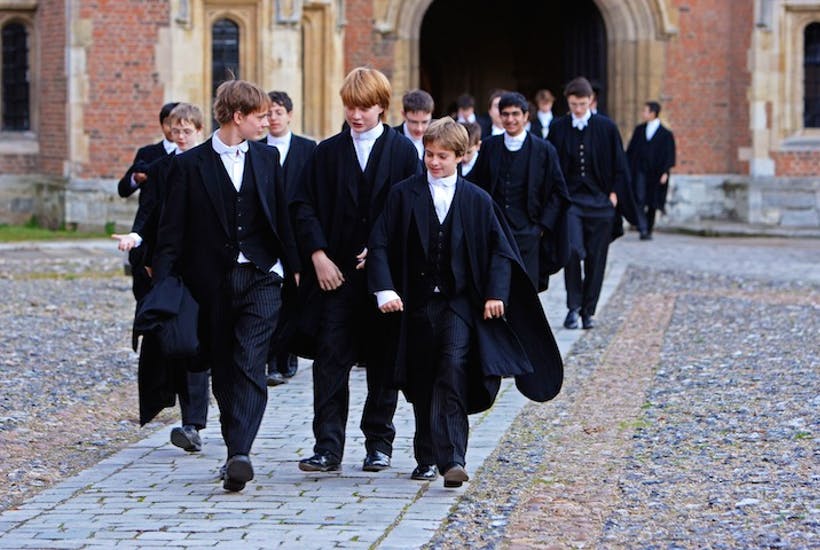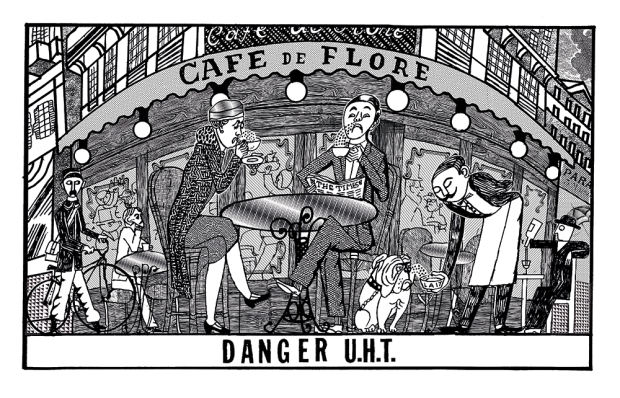It is one of the great mysteries of modern British politics: how public schools managed to survive three periods of Labour government with their tax breaks intact. How was it that an education secretary, Anthony Crosland, could say: ‘If it’s the last thing I do, I’m going to destroy every fucking grammar school in England, and Wales and Northern Ireland’, and yet do nothing to make life difficult for independent schools? Suzi Leather, Tony Blair’s appointment as head of the Charity Commission, demanded private schools do more to justify their charitable status. They upped their bursaries a bit and invited state schools to use their swimming pools every so often, but were otherwise allowed to carry on avoiding VAT and being let off much of their business rates bill.
Yet could it now be a Conservative government which finally sends the taxman round for a slice of St Cake’s? Michael Gove, of course, is no longer education secretary, nor even in the government. Yet he recently said that the government should stop regarding ‘the education of the children of plutocrats and oligarchs to be charitable activity’, a point which sent the independent sector flapping around for a response, which in turn reminded everyone how little they understand the problem they face.
When a group of organisations representing the independent sector, including the Independent Schools Council and the Headmasters’ and Headmistresses’ Conference, got together and produced a round-robin letter to the Times in response to Gove’s article, the best argument they could come up with was that ‘educating the 500,000 independent school pupils in the state sector would cost £3 billion a year’.
Putting VAT on school places and charging full business rates would not close the independent school sector any more than alcohol duties have finished the drinks industry. It might, though, spur some struggling schools to convert into academies — thus saving the state the capital cost of building new schools.
Independent schools have invited an attack on their charitable status owing to their shameless march upmarket, which has lost them many of their former supporters. Where in Anthony Crosland’s day private schooling was an option for a huge swath of the middle class, years of inflation in fees have steadily squeezed out one profession after another. Since 2007, the average day school has raised its fees by 59 per cent — a 29 per cent rise in real terms. As for boarding schools, the annual fee for a single pupil would swallow the entire pre-tax income of many middle-class professionals: Eton charges more than £37,000 a year and even that is topped by some lower-profile schools such as Abingdon, at more than £38,000.
In reply to Michael Gove, private schools drew attention to the £350 million in means-tested bursaries and other assistance which they say they offer to ‘disadvantaged’ pupils. But it is a demonstration of just how far they have drifted from the socioeconomic mainstream that their definition of ‘disadvantaged’ now includes parents who are earning up to £120,000 a year — the level up to which pupils at £7,800-a-term St Paul’s School in London are eligible for help.
In the state sector an average of £5,210 is spent per pupil per year, or £6,280 if you include capital investment. In the independent sector the average day school now charges more than twice this. Education is only part of their product; schools are pitching themselves as hotels, leisure centres and travel agents. Dormitories have been replaced with private en suites. Thanks to an arms race in facilities, dedicated concert halls are now standard: 52 per cent of independent schools have those, and 29 per cent have a dance studio.
When I asked the Independent Schools Council why the private sector seemed only interested in providing a premium product, costing on average twice what the state sector spends, I was told that independent schools ‘aren’t all Etons’ and that I should speak to the head of Gosfield School in Essex ‘where fees start at £4,500’. This turned out not quite to be the case: when I looked up the fees, they were £4,190 a term (£12,570 a year) for a Year 7 pupil and £5,085 a term (£15,255 a year) for a sixth-form pupil. There are bursaries available: but just three a year: one at 100 per cent discount and two at 50 per cent discount. Gosfield might not be Eton, but its website seems to be straining to say it is not far out of its league, boasting that it is ‘set in 100 acres of beautiful parkland’ with an ‘onsite, fully accredited forest school’.
The head, Sarah Welch, seems not the least bit worried her school might be pricing itself out of the market, saying it is full of the children of ‘local businessmen and builders’. ‘We’ve got a lot of first-time buyers of private education,’ she told me, adding, ‘We produce something of value that parents will budget for.’
Private schools have got away — so far — with charging what they do partly as a result of fortunes falling into the hands of some middle-class families courtesy of inheritance and the house-price boom. Schools are increasingly looking abroad, too. The number of oligarchs’ children isn’t as high as is often made out — 5.3 per cent of pupils are non-British and with their parents living overseas. Gosfield, for example, says it has only two overseas pupils. Yet the numbers of pupils from Russia and China in schools represented by the Independent Schools Council has trebled over the past decade.
Private schools, like London property developers, are falling for the temptation to position themselves shamelessly at an international market. It is only a matter of time before an English public school decides to compete head-on with the most expensive Swiss finishing schools, which charge up to £70,000.
But it is hard to see how the entire independent sector is going to get away with that approach. Sooner or later private schools will be in a situation like the London property market is now in: with an excess of luxury product, and nothing affordable to offer local buyers. As Andrew Halls, headmaster of King’s College School in Wimbledon, said three years ago: ‘We are in danger of coming across as greedy because we can charge what appears to be limitless fees, but in truth there is a fees timebomb ticking away. It feels like the build-up to the banking crisis.’
The independent sector may end up asking itself why, a decade ago, when fees were already spiralling out of control, it didn’t stop and ask: how can we strip away some of these costs and compete in the mainstream market? Instead, it was left to Michael Gove’s free schools to take up the mantle. Free schools aren’t interested in acquiring 100 acres of parkland. It is perfectly possible to offer a rigorous academic education in a disused office block. The new sixth form at Higham Lane, a free school in Nuneaton, is housed in premises built from secondhand Portakabins in six months flat, but that hasn’t stopped it becoming one of the top 100 best-performing non-selective secondary schools in the country.
Rather than lower school fees, the independent sector has hit on the idea of appealing for public subsidy. Last December, the Independent Schools Council started lobbying for what it calls a Jointly Funded Places Scheme. This is a variation on the old Assisted Places Scheme, but where the government would put in only £5,500 per pupil, with private schools covering the rest through a bursary. ‘We are already in a situation where the government funds places at some schools, such as Chetham’s Music School in Manchester,’ says Julie Robinson, the council’s secretary general. ‘This would provide extra school places at no great cost.’
But why should the government bother with part-funding 10,000 places at private schools when it has a free schools programme which is helping raise standards for millions? Free schools have become the budget schools that the independent sector failed to develop. In many ways they are themselves independent. They offer a far greater choice in educational approach than has previously been the case, and they are part of general increase in standards in the state sector.
Educationally, the independent sector is beginning to struggle to present itself as value for money. For years, private schools have been able to brag about being top of academic league tables (apart from those which refused to publish their results). Of the top 20 schools at A-level, 16 last year were independent. (Of the rest, two were academies, one a free school and one a community comprehensive.)
Schools deserve to be judged — and will be judged by most parents — according to what value they add to children’s academic education. Many independent schools have set standards on this, and have helped the state sector raise its own game.
But how much stronger the independent sector would be had it competed in the mass market for education, not just pitched itself at the top end. If private schools want to offer something more than education, and lure the children of the wealthy with fancy facilities, that is fine. But it is education which is the charitable activity, not the provision of a luxury lifestyle. If this or a future government decides to tax private schools, the independent sector will have no one but itself to blame.
Got something to add? Join the discussion and comment below.
Get 10 issues for just $10
Subscribe to The Spectator Australia today for the next 10 magazine issues, plus full online access, for just $10.
You might disagree with half of it, but you’ll enjoy reading all of it. Try your first month for free, then just $2 a week for the remainder of your first year.















Comments
Don't miss out
Join the conversation with other Spectator Australia readers. Subscribe to leave a comment.
SUBSCRIBEAlready a subscriber? Log in